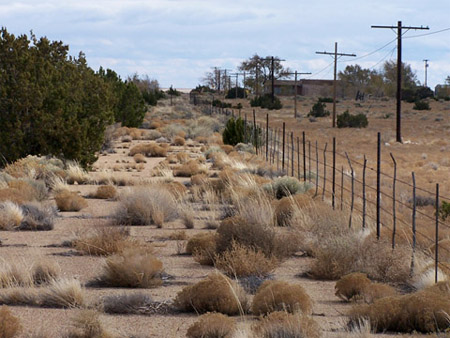Route 66: A History
Alignments and Road Improvements
Route 66 originated in 1926 as a pre-existing network of local roads, united on federal maps under the newly-designed U.S. Highway 66 shield. Nearly 400 miles of the 2,448 mile-long highway ran through northern Arizona. Most of those miles had not been paved at the time of Route 66's commissioning; some portions of the road consisted of no more than wooden planks laid out across the sand (Kelly 20). Under these conditions, the 60-mile drive from Flagstaff to Winslow, Arizona might take one or two days (Kelly 21) and multiple tire changes.

Workers at the site of U.S. Highway Route 66 construction; James Maddox is second from the left, 1926.
Andrew L. Wolf moved to Flagstaff in 1932 to attend the Teacher’s College, traveling portions of Route 66 along the way. Mr. Wolf recounted the conditions of the road: "Highway 66 was just a wide track, no paving on it. When I drove from Kingman to Flagstaff I didn't travel on one inch of pavement, it was all gravel road and there would be turn-outs if you saw another car coming, you'd have to turn out and let it go by" (Wolf).
As the nation pushed to improve its federal highway system in the mid- and late-1930s, road crews widened and paved the final stretches of Arizona’s Route 66, sidestepping certain portions of the original 1926 alignment in favor of more direct routes. The United States government laid additional realignments in 1937, after World War II, and again in 1952, but even the more modern alignments were dangerous: in 1956, one out of six Arizona traffic fatalities occurred on Route 66 (Kelly 178).

This is the 1947 alignment that runs through the Twin Arrows interchange on I-40. Looking east, Toonerville (now a private residence) lies ahead on the right.
At the time of its official decommissioning in 1985, most of old Route 66 had already been replaced by I-40. The last stretch of Route 66 in America, bypassed in 1984, went through Williams, Arizona. Today, more than 200 miles of Route 66 still exist in Arizona, with the longest unbroken stretch of road in the United States lying east of Seligman to Topock, Arizona. Although greatly diminished, Route 66 continues to play a valuable role in northern Arizona’s cultural and economic landscape.
Angel Delgadillo, co-founder of the Historic Route 66 Association of Arizona and longtime owner of a barbershop along Route 66 in Seligman, believes that the old road is a crucial part of American history and must be preserved.
"To think that the United States government decommissioned Route 66 in 1985 and told the world 'the end of an era,'" said Mr. Delgadillo. "Well, it was gone, but the fact that we brought it back, we helped to preserve a little bit of America that had been discarded, thrown away, lost forever. In America, we bury more of our history than we can rebuild. The European countries, they preserve and preserve, and we don’t. So we have saved a little bit of America" (Delgadillo).

 Preservation
Preservation